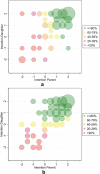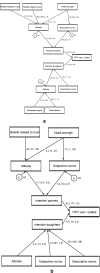Human papillomavirus vaccination uptake: a longitudinal study showing ethnic differences in the influence of the intention-to-vaccinate among parent-daughter dyads
- PMID: 32966170
- PMCID: PMC8018452
- DOI: 10.1080/21645515.2020.1808411
Human papillomavirus vaccination uptake: a longitudinal study showing ethnic differences in the influence of the intention-to-vaccinate among parent-daughter dyads
Abstract
Introduction: It is unclear what role daughters play in the decision-making process regarding HPV vaccination. Therefore, we explored the impact of HPV vaccination intention among parents and their 12-13 year-old daughters on HPV vaccination uptake.
Methods: In February 2014 parents/guardians and their 12-13 year-old daughters were invited to complete a questionnaire about socio-psychological determinants of the decision-making process regarding HPV vaccination. Vaccination status of the daughter was retrieved from the national vaccination database after the last possible vaccination date in 2014. The association between HPV vaccination uptake and intention, and determinants of intention, was jointly assessed using a generalized structural equation model, stratified by origin of parents (Dutch versus non-Dutch).
Results: In total, 273 Dutch parent-daughter dyads and 165 non-Dutch dyads were analyzed for this study. HPV vaccination uptake was 90% (246/273) and 84% (139/165) in the Dutch and non-Dutch group, respectively. In the Dutch group, high parental intention (β = 2.3, 95%CI 1.2-3.3) and high daughters' intention (β = 1.5, 95%CI 0.41-2.6) were significantly associated with HPV vaccination uptake. In the non-Dutch group, high daughters' intention (β = 1.2, 95%CI 0.16-2.2) was significantly associated with HPV vaccination, but high parental intention was not (β = 0.52, 95%CI -0.47-1.5). Attitude was the most prominent socio-psychological determinant associated with vaccination intention among all groups.
Conclusion: In the non-Dutch group, only daughters' intention was significantly associated with HPV vaccination uptake, whereas in the Dutch group both the parents' and the daughters' intention were significantly associated with uptake. The role of the child in the decision-making process might need to be taken into account when developing new interventions focused on increasing HPV vaccination uptake, especially among individuals of non-Dutch origin.
Keywords: HPV; Human papillomavirus; The Netherlands; parent-daughter dyads; vaccination; vaccination acceptability; vaccination intention; vaccination uptake.
Figures


Similar articles
-
A longitudinal study on determinants of HPV vaccination uptake in parents/guardians from different ethnic backgrounds in Amsterdam, the Netherlands.BMC Public Health. 2017 Feb 21;17(1):220. doi: 10.1186/s12889-017-4091-4. BMC Public Health. 2017. PMID: 28222722 Free PMC article.
-
Factors associated with parental Human Papillomavirus (HPV) vaccination intention of daughter: A national survey in Finland.Vaccine. 2024 Jan 25;42(3):701-712. doi: 10.1016/j.vaccine.2023.12.026. Epub 2024 Jan 3. Vaccine. 2024. PMID: 38172018
-
Parental Factors Affecting Decision to Vaccinate Their Daughters against Human Papillomavirus.Cancer Prev Res (Phila). 2023 Mar 1;16(3):133-138. doi: 10.1158/1940-6207.CAPR-22-0412. Cancer Prev Res (Phila). 2023. PMID: 36607702
-
Sociocultural-psychological predictors influencing parents' decision-making regarding HPV vaccination for their adolescent daughters in mainland China: An extended TPB model.Front Public Health. 2023 Jan 6;10:1035658. doi: 10.3389/fpubh.2022.1035658. eCollection 2022. Front Public Health. 2023. PMID: 36684984 Free PMC article.
-
A scoping review of the use of parent-adolescent dyads in HPV vaccination research.Patient Educ Couns. 2024 Jan;118:108007. doi: 10.1016/j.pec.2023.108007. Epub 2023 Oct 11. Patient Educ Couns. 2024. PMID: 37847989
Cited by
-
Coverage and determinants of COVID-19 child vaccination in Munich, Germany in October 2022-January 2023: Results of the COVIP-Virenwächter study.Eur J Pediatr. 2024 Sep;183(9):3727-3738. doi: 10.1007/s00431-024-05617-0. Epub 2024 Jun 8. Eur J Pediatr. 2024. PMID: 38850330
-
Understanding the impact process of vaccine adoption for COVID-19.Hum Vaccin Immunother. 2022 Nov 30;18(6):2099166. doi: 10.1080/21645515.2022.2099166. Epub 2022 Jul 29. Hum Vaccin Immunother. 2022. PMID: 35905384 Free PMC article.
-
Understanding the continuous vaccination of the COVID-19 vaccine: an empirical study from China.Hum Vaccin Immunother. 2021 Dec 2;17(12):4954-4963. doi: 10.1080/21645515.2021.2013080. Epub 2021 Dec 10. Hum Vaccin Immunother. 2021. PMID: 34893013 Free PMC article.
-
Long-term effect of mobile phone-based education and influencing factors of willingness to receive HPV vaccination among female freshmen in Shanxi Province, China.Hum Vaccin Immunother. 2022 Nov 30;18(5):2051990. doi: 10.1080/21645515.2022.2051990. Epub 2022 Apr 21. Hum Vaccin Immunother. 2022. PMID: 35446735 Free PMC article. Clinical Trial.
References
-
- Newman PA, Logie CH, Lacombe-Duncan A, Baiden P, Tepjan S, Rubincam C, Doukas N, Asey F. Parents’ uptake of human papillomavirus vaccines for their children: a systematic review and meta-analysis of observational studies. BMJ Open. 2018;8:e019206. doi:10.1136/bmjopen-2017-019206. - DOI - PMC - PubMed
Publication types
MeSH terms
Substances
Grants and funding
LinkOut - more resources
Full Text Sources
Medical
